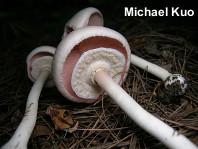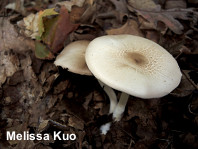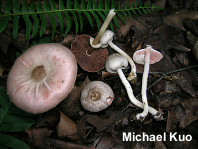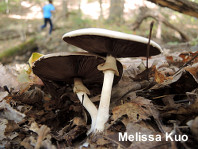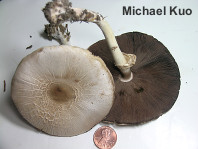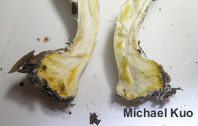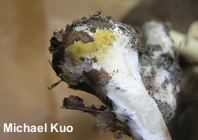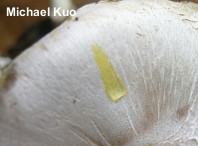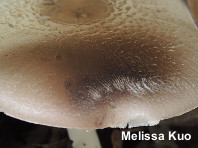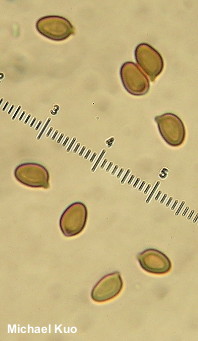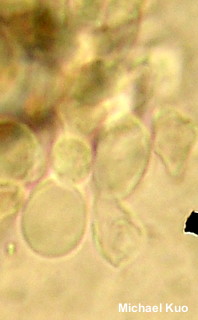| Major Groups > Gilled Mushrooms > Dark-Spored > Agaricus > Agaricus leptocaulis |

|
Agaricus leptocaulis [ Basidiomycota > Agaricales > Agaricaceae > Agaricus . . . ] by Michael Kuo This woodland, eastern North American species of Agaricus was given a name in 2016 by Agaricus expert Rick Kerrigan, who used the epithet leptocaulis to emphasize the thin stem of the species. It is similar to Agaricus pocillator and Agaricus placomyces—but the former species features a cup-like bulb at the base of the stem and the latter species has a thicker stem. Like most species in the Xanthodermatei section of Agaricus, Agaricus leptocaulis stains yellow and features yellow flesh in the base of the stem. There are apparently two versions of Agaricus leptocaulis: a primarily white, southeastern United States version, and a brown-centered Midwestern version. Kerrigan (2016) noted that the Ohio collection he had studied had "a darker disc and slightly smaller spores" than North Carolina collections; the Illinois and Indiana collections featured here match the Ohio collection (which can be seen at mushroomobserver.org, observation 24015) and lend support to the idea that the brown-centered version of the species may be more northern than the white version. Until Kerrigan's publication I treated Agaricus leptocaulis as "Agaricus placomyces," both here and in Mushrooms of the Midwest (2014). Phillips (1991/2005) apparently does the same in Mushrooms and Other Fungi of North America. Description: Ecology: Saprobic; growing alone or gregariously under hardwoods and conifers in forests; summer and fall; southeastern United States, north to the southern Appalachians. The illustrated and described collection is from Georgia. Cap: 3–9 cm; convex at first, becoming broadly convex or flat in age; dry; creamy white with a dark brown center; often becoming finely fibrillose; in wet weather sometimes developing pink shades. Gills: Free from the stem; crowded; short-gills frequent; white, becoming pink, then brown; when young covered by a rubbery, whitish partial veil. Stem: 7–13 cm long; 0.5–1 cm thick; more or less equal above a bulbous base; bulb usually small and abrupt; whitish, bruising yellow; sometimes pinkish toward the apex; with a thick whitish ring; basal mycelium white and often prominent. Flesh: White throughout; staining bright yellow in the base. Odor and Taste: Odor phenolic or not distinctive. Chemical Reactions: KOH yellow on cap surface. Spore Print: Brown. Microscopic Features: Spores 5–6 x 3–4 µm; more or less ellipsoid; smooth; thick-walled; brown in KOH. Basidia 4-sterigmate. Cheilocystidia 20–25 x 6–10 µm; clavate to subglobose; septate; smooth; thin-walled; hyaline to brownish in KOH. Pileipellis a cutis; elements 2.5–7.5 µ wide, smooth, golden brown in KOH. REFERENCES: Kerrigan, 2016. (Phillips, 1991/2005 ["pocillator"]; Kuo & Methven, 2014 ["pocillator"].) Herb. Kuo 06099601, 09020102, 07140309, 06290701, 10211701. This site contains no information about the edibility or toxicity of mushrooms. |
© MushroomExpert.Com |
|
Cite this page as: Kuo, M. (2018, January). Agaricus leptocaulis. Retrieved from the MushroomExpert.Com Web site: http://www.mushroomexpert.com/agaricus_leptocaulis.html |
